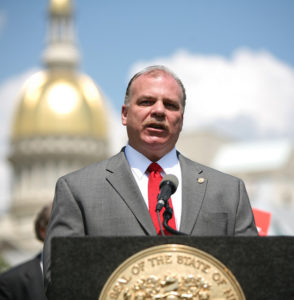Yesterday in Old Bridge Governor Christie laid out the planks of his education reform platform. Here are his six initiatives, although he didn’t neglect forget to leaven the proceedings with his customary aplomb, including these bon mots (courtesy of PolitickerNJ):
“Tenure is the sclerosis that coats the veins of our school system.”
“I don’t bash teachers. I bash their stubborn, self-interested union. That’s who I bash.”
“We are paying a king’s fortune for an education system that isn’t giving our children the royal treatment.”
Here’s his proposals; the last two would require legislative approval.
- Spend $10 million on our data system NJ SMART ( by the way, see today’s NJ Spotlight on its gaping holes and how its incompleteness was a major deficit in our Race To The Top quest) so that we can tie student achievement to teacher effectiveness.
- Create a Task Force on Teacher Effectiveness to decide how to link teacher pay and student achievement (originally planned as an unwieldy 36 members, now down to 9).
- Create alternate route programs for principals.
- Create rank of “master teacher” and “master principal,” with added incentives of higher pay, more professional development, and, potentially, leadership of their own charter schools.
- Restructure teacher compensation to eliminate seniority-based raises.
- Base tenure on merit.
The NJEA responded immediately with a press release citing the results of this past summer’s study by the Economic Policy Institute (EPI) called “Problems with Use of Student Test Scores to Evaluate Teachers.” President Barbara Keshishian added,
As Gov. Christie sets out to pursue an education agenda that has significant implications for the future of New Jersey’s entire public education system, New Jersey residents and policymakers would be wise to ask whether it is an agenda based on sound educational practice, or simply another attack on New Jersey’s excellent public schools.
(New Jersey’s “excellent public schools?” When will she retire that old bromide? Jeez. Tell that to the kids in Newark and Camden and Trenton and Paterson.)
One salient point: EPI’s study was funded by NEA. Its Board of Directors includes Presidents of the International Association Of Machinists and Allied Workers, Service Employees International Union, Communication Workers of America, United Steelworkers of America, United Auto Workers, American Federation of State, County, and Municipal Employees, Workers United, Service Employees International Union, AFL-CIO, American Federation of Teachers. (On July 30th EPI published another study arguing that NJ’s public employees are underpaid.)
The anti-value-added model evalution cadre – those who oppose using student academic growth to evaluate teacher effectiveness – is strong, boasting such luminaries as Diane Ravitch, Linda Darling-Hammond, and, more locally, Bruce Baker at Rutgers. But the logic is specious. Data-driven teaching evaluations aren’t perfect. Therefore, let’s rely on the current system, which is almost universally acknowledged to be devoid of all meaning.
Remember “The Widget Effect,” the 2009 study from The New Teacher Project, which examined teacher evaluations in four states — Arkansas, Colorado, Illinois and Ohio – and determined that “all teachers are rated good or great:”
In districts that use binary evaluation ratings (generally “satisfactory” or “unsatisfactory”), more than 99 percent of teachers receive the satisfactory rating. Districts that use a broader range of rating options do little better; in these districts, 94 percent of teachers receive one of the top two ratings and less than 1 percent are rated unsatisfactory.
Excellence goes unrecognized
When all teachers are rated good or great, those who are truly exceptional cannot be formally identified. Fifty-nine percent of teachers and 63 percent of administrators say their district is not doing enough to identify, compensate, promote and retain the most effective teachers.
Our current system of evaluating teachers stinks, say teachers, administrators, education experts, and policy analysts. A proposed alternative – value-added models – is better, but not perfect. Therefore, let’s keep the one that stinks. If logic were an item in a standardized test, opponents of value-added models would fail.



10 Comments